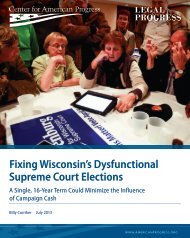Improving Academic Preparation for College - Center for American ...
Improving Academic Preparation for College - Center for American ...
Improving Academic Preparation for College - Center for American ...
Create successful ePaper yourself
Turn your PDF publications into a flip-book with our unique Google optimized e-Paper software.
Endnotes<br />
1 Paul Osterman, “<strong>College</strong> <strong>for</strong> All? The Labor Market <strong>for</strong> <strong>College</strong>-Educated Workers,”<br />
(Washington: <strong>Center</strong> <strong>for</strong> <strong>American</strong> Progress, 2008).<br />
2 U.S. Census Bureau, “Historical Income Tables,” available at http://www.census.<br />
gov/hhes/www/income/histinc/p18.html.<br />
3 Osterman, “<strong>College</strong> <strong>for</strong> All?”<br />
4 National <strong>Center</strong> <strong>for</strong> Education Statistics, “The Condition of Education: Indicator<br />
23, Student Ef<strong>for</strong>t and Educational Progress,” available at http://nces.ed.gov/<br />
programs/coe/2006/section3/indicator23.asp.<br />
5 National <strong>Center</strong> <strong>for</strong> Education Statistics, “Fast Facts,” available at http://nces.<br />
ed.gov/fastfacts/display.asp?id=51.<br />
6 U.S Department of Education, “Condition of Education: 2004, Indicator 31”<br />
(Washington: 2004); Also see discussion and other estimates available at http://<br />
www.highereducation.org/crosstalk/ct0107/voices0107-kirst.shtml.<br />
7 Susan Goldberger, “Doing the Math, What it Means to Double the Number of<br />
Low-Income <strong>College</strong> Graduates.” In Nancy Hoffman, Joel Vargas, Andrea Venezia,<br />
& Marc S. Miller, eds., Minding the Gap, Why Integrating High School with <strong>College</strong><br />
Makes Sense and How to Do It (Cambridge: Harvard Education Press, 2007).<br />
8 Sara Goldrick-Rab and Josipa Roksa, “A Federal Agenda <strong>for</strong> Promoting Student Success<br />
and Degree Completion” (Washington: <strong>Center</strong> <strong>for</strong> <strong>American</strong> Progress, 2008).<br />
9 Ibid.<br />
10 Jay Greene, “Public High School Graduation and <strong>College</strong>-Readiness Rates:<br />
1991–2002” (New York: Manhattan Institute, 2005).<br />
11 Goldberger, “Doing the Math.” Goldberger’s measure of preparedness<br />
combines several measures from high school transcripts, including senior year<br />
rank, GPA, SAT and ACT scores, and NELS 1992 math and reading composite<br />
test score percentiles.<br />
12 Ibid.<br />
13 Clif<strong>for</strong>d Adelman, “Answers in the Toolbox” (Washington: U.S. Department of<br />
Education, 1999).<br />
14 Elaine M. Allensworth, “Update: From High School to the Future, A First Look at<br />
Chicago Public School Graduates’ <strong>College</strong> Enrollment, <strong>College</strong> <strong>Preparation</strong>, and<br />
Graduation from Four Year <strong>College</strong>s” (Chicago: Consortium on Chicago Schools<br />
Research, 2006).<br />
15 Ibid.<br />
16 Valerie E. Lee, Julia B. Smith and Robert G. Croninger, ”How High School Organization<br />
Influences the Equitable Distribution of Learning in Mathematics and Science,”<br />
Sociology of Education, 70 (April1997); Valerie E. Lee, Julia B. Smith and<br />
Robert G. Croninger, “Course-taking, Equity, and Mathematics Learning: Testing<br />
the Constrained Curriculum Hypothesis in U.S. Secondary Schools,” Educational<br />
Evaluation and Policy Analysis, 19 (2) (Summer 1997).<br />
17 Michael W. Kirst and Kathy Reeves Bracco, “Bridging the Great Divide: How the<br />
K-12 and Postsecondary Split Hurts Students, and What Can Be Done About It.” In<br />
Michael W. Kirst and Andrea Venezia, eds., From High School to <strong>College</strong>: <strong>Improving</strong><br />
Opportunities <strong>for</strong> Success in Postsecondary Education (Jossey-Bass, 2004).<br />
18 Peter Sacks, “How <strong>College</strong>s Perpetuate Inequality,” Chronicle of Higher Education,<br />
53 (19) (2007).<br />
19 Andrea Venezia’s email correspondence with David Conley, March 20, 2008.<br />
30 <strong>Center</strong> <strong>for</strong> american progress | improving academic preparation <strong>for</strong> <strong>College</strong><br />
20 David Conley, <strong>College</strong> Knowledge: What it Takes <strong>for</strong> Students to Succeed and<br />
How We Can Help Them Get Ready (Indianapolis: Jossey-Bass, 2005).<br />
21 David Conley, “Toward a More Comprehensive Conception of <strong>College</strong> Readiness”<br />
(Eugene: Educational Policy Improvement <strong>Center</strong>, 2007).<br />
22 Achieve, “K-12 Benchmarks,” available at http://www.achieve.org/node/479.<br />
23 Melissa Roderick and others, “From High School to the Future: Potholes on the<br />
Road to <strong>College</strong>” (Chicago: Consortium on Chicago School Research, 2008).<br />
24 Ibid.<br />
25 <strong>College</strong> Summit, “Our Track Record,” available at http://www.collegesummit.<br />
org/school-districts/superintendents-and-principals/delivering-results/ourtrack-record/.<br />
26 ACT, “ACT National Curriculum Survey 2005–2006” (Iowa City: ACT, 2007)<br />
27 See, <strong>for</strong> instance, William L. Sanders June and Rivers “Cumulative and Residual<br />
Effects of Teachers on Future Student <strong>Academic</strong> Achievement, Research<br />
Progress Report” (Knoxville: University of Tennessee, 1996); Steven G. Rivkin, Eric<br />
Hanushek, and John F. Kain, “Teachers, Schools, and <strong>Academic</strong> Achievement,”<br />
Econometrica 73 (2) (2005); Jonah E. Rockoff, “The Impact of Individual Teachers<br />
on Student Achievement: Evidence from Panel Data,” <strong>American</strong> Economic<br />
Review, 94(2) (2004).<br />
28 Jennifer B. Presley and Yuqin Gong, “The Demographics and <strong>Academic</strong>s of <strong>College</strong><br />
Readiness in Illinois” (Edwardsville: Illinois Education Research Council, 2005).<br />
29 Michael Kirst and Michael Usdan, “The History of the Separation Between K-12 and<br />
Postsecondary Education.” In Nancy Hoffman, Joel Vargas, Andrea Venezia, and<br />
Marc S. Miller, eds., Minding the Gap, Why Integrating High School with <strong>College</strong><br />
Makes Sense and How to Do It, (Cambridge: Harvard University Press, 2007).<br />
30 Ibid.<br />
31 See, <strong>for</strong> example, Andrea Venezia, Michael W. Kirst, and Anthony L. Antonio, “Betraying<br />
the <strong>College</strong> Dream, How Disconnected K-12 and Postsecondary Education<br />
Systems Undermine Student Aspirations” (Palo Alto: Stan<strong>for</strong>d University, 2003).<br />
32 In this paper, we use the term “academic support” to mean additional academic<br />
help <strong>for</strong> students who are struggling. This support could take the <strong>for</strong>m of tutoring,<br />
additional course work, or additional instructional time in particular content areas.<br />
33 Achieve, “Closing the Expectations Gap, An Annual 50-State Progress Report on<br />
the Alignment of High School Policies with the Demands of <strong>College</strong> and Careers”<br />
(Washington: Achieve, 2008)<br />
34 Ibid.<br />
35 <strong>Center</strong> on Education Policy, “State High School Exit Exams: A Move Toward Endof-Course<br />
Exams” (Washington: <strong>Center</strong> on Education Policy, 2008).<br />
36 Ibid.<br />
37 <strong>Center</strong> on Education Policy, “State High School Exit Exams: Working to Raise Test<br />
Scores” (2007).<br />
38 Achieve, “Closing the Expectations Gap.”<br />
39 David Spence, “State <strong>College</strong> Readiness Initiatives and Community <strong>College</strong>s.” In<br />
Andrea Conklin Bueschel and Andrea Venezia, eds., New Directions <strong>for</strong> Community<br />
<strong>College</strong>s (Forthcoming Spring 2009).









